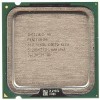Intel 640 User Guide - Page 36
Correction Factors for the On-Die Thermal Diode - review
 |
UPC - 683728178901
View all Intel 640 manuals
Add to My Manuals
Save this manual to your list of manuals |
Page 36 highlights
Thermal Management Logic and Thermal Monitor Feature R 4.2.7.2 Correction Factors for the On-Die Thermal Diode A number of issues can affect the accuracy of the temperature reported by thermal diode sensors. These include the diode ideality and the series resistance that are characteristics of the processor on-die thermal diode. The processor datasheet provides the specification for these parameters. The trace layout recommendations between the thermal diode sensors and the processor socket should be followed as listed in the vendor datasheets. The design characteristics and usage models of the thermal diode sensors should be reviewed in the datasheets available from the manufacturers. The choice of a remote diode sensor measurement component has a significant impact to the accuracy of the reported on-die diode temperature. The component vendors offer components that have stated accuracy of ± 3° C to ± 1°C. The improved accuracy generally comes from the number of times a current is passed through the diode and the ratios of the currents. Consult the vendor datasheet for details on their measurement process and stated accuracy. The ideality factor, n, represents the deviation from ideal diode behavior as exemplified by the diode equation: IFW = IS * (E qVD/nkT -1) Where I FW = forward bias current, IS = saturation current, q = electronic charge, V = voltage across the diode, k = Boltzmann Constant and T = absolute temperature (Kelvin). This equation determines the ideality factor of an individual diode. For the purpose of determining a correction factor to use with the thermal sensor, the ideality equation can be simplified to the following: TERROR = TMEASURED * (1 - NACTUAL / NTRIM) Where TERROR = correction factor to add to the reported temperature, TMEASURED = temperature reported by the thermal sensor (Kelvin), NACTUAL = the ideality of the on-die thermal diode, NTRIM = the assumed ideality used by the thermal sensor. For the range of temperatures where the thermal diode is being measured, 30-80 °C this error term is nearly constant. The value of NTRIM is available from the datasheet of the device measuring the processor on die thermal diode. NACTUAL can be assumed to be typical for this equation. The series resistance, RT, is provided to allow for a more accurate measurement of the on-die thermal diode temperature. RT, as defined, includes the pads of the processor but does not include any socket resistance or board trace resistance between the socket and the external remote diode thermal sensor. RT can be used by remote diode thermal sensors with automatic series resistance cancellation to calibrate out this error term. Another application is that a temperature offset can be manually calculated and programmed into an offset register in the remote diode thermal sensors as exemplified by the equation: Terror = (RT * (N - 1) * IFWmin ) / (nk/q * IN ln N) Where T = sensor temperature error, N = sensor current ratio, k = Boltzmann Constant, ERROR q = electronic charge. 36 Thermal/Mechanical Design Guide















